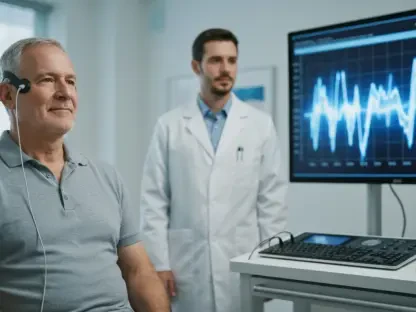In the chaotic pulse of an emergency room, where every second can tip the balance between life and death, a staggering reality unfolds: millions of patients flood these high-stakes environments yearly, often outnumbering the staff available to save them. Picture a nurse, sweat beading on their brow, racing to decide who among a sea of suffering needs care first—a heart attack victim or a child with a fever spiking dangerously. Now, imagine a machine stepping into this fray, promising to sort through the chaos with cold precision. Could artificial intelligence (AI) truly match the gut instinct and honed skills of human clinicians in such critical moments? This question is no longer a distant dream but a pressing challenge reshaping emergency medicine today.
Why Triage Matters More Than Ever
The significance of triage—the art and science of prioritizing patients based on urgency—cannot be overstated in emergency departments (EDs) grappling with overcrowding and chronic staff shortages. With patient volumes often exceeding capacity, the pressure on doctors and nurses to make split-second decisions has never been greater. A single misstep in assessing urgency can delay life-saving care, amplifying the stakes. As healthcare systems strain under these burdens, the allure of AI as a potential ally in streamlining triage decisions grows, offering a glimmer of hope amid systemic challenges like burnout and resource scarcity.
Unpacking the High-Stakes Arena of Emergency Rooms
Emergency rooms are battlegrounds where time is the enemy, and every decision carries profound consequences. The environment is a whirlwind of urgency—beeping monitors, anguished cries, and the constant shuffle of stretchers. In this setting, triage serves as the first line of defense, determining whether a patient with chest pain gets immediate attention or waits behind someone with a less obvious but equally deadly condition. The integration of AI into this space isn’t just about efficiency; it’s about survival. Yet, the question looms: can a machine replicate the nuanced judgment forged by years of human experience in such unpredictable scenarios?
AI Versus Human Expertise: A Head-to-Head Comparison
Delving into recent research reveals a stark contrast between AI and human performance in triage settings. Studies show doctors achieving a 70.6% accuracy rate using standardized systems like the Manchester Triage System, outpacing nurses at 65.5% and leaving AI trailing at 50.4%. Sensitivity, the ability to spot truly urgent cases, also tilts heavily in favor of humans, with doctors hitting 83.0% compared to AI’s modest 58.3%. These numbers paint a clear picture: while technology has potential, it struggles to match the precision of seasoned clinicians in identifying critical needs under pressure.
Beyond raw accuracy, AI shows a curious strength in flagging life-threatening cases, achieving a 27.3% accuracy rate in the most urgent category—surpassing nurses at 9.3%. However, this caution often results in over-triaging, assigning high priority to less critical cases, which risks clogging already strained ED workflows. In complex scenarios, such as those requiring surgical intervention, human expertise shines brighter, with doctors demonstrating 68.4% reliability against AI’s lackluster 39.5%. These disparities highlight a fundamental gap in machine judgment when faced with the intricate variables of medical emergencies.
Hearing from the Trenches: What Experts Say
On the front lines, the voices of medical professionals carry weight in this debate over AI’s role. Dr. Renata Jukneviciene, a lead researcher at Vilnius University, asserts, “AI can support prioritization of critical cases, but it must never replace human oversight.” This sentiment echoes through the halls of emergency medicine, where cautious optimism prevails. Dr. Barbra Backus, a prominent figure at the European Emergency Medicine Congress, reinforces this view, stating, “While AI can speed up decisions, its recommendations must be critically reviewed by clinicians.” Their insights, drawn from real-world testing at Vilnius University Hospital Santaros Klinikos, underscore a shared belief: technology is a tool, not a substitute for human discernment.
These expert perspectives reveal a deeper tension in the field. While the potential for AI to assist during peak overcrowding or with less experienced staff is acknowledged, there’s a palpable concern about over-reliance. The risk of workflow disruptions due to AI’s tendency to over-triage looms large, as does the need for rigorous validation in diverse ED settings. This blend of hope and skepticism shapes the ongoing dialogue about how to responsibly weave AI into the fabric of emergency care.
Charting the Path Forward: Integrating AI with Care
Turning from theory to practice, a roadmap for AI integration in triage emerges with patient safety at its core. Hospitals must position AI as a decision-support mechanism, not a replacement for clinicians, ensuring it aids rather than dictates during high-volume crises. Training programs are essential, equipping staff to interpret AI outputs and mitigate risks like over-triaging, which can exacerbate bottlenecks in emergency workflows. Clear protocols for human oversight should also be established, guaranteeing that every machine-generated recommendation undergoes clinical scrutiny.
Further steps include piloting AI systems tailored specifically for medical triage, moving beyond general models to enhance accuracy in real-world ED contexts. Continuous monitoring and adaptation are critical, with performance assessments addressing limitations such as small sample biases or single-center study constraints. Starting from 2025, ongoing evaluations over the next few years could refine AI’s role, ensuring it evolves in step with the dynamic needs of emergency medicine. This cautious, iterative approach offers a balanced way to harness technology while safeguarding the human touch at the heart of care.
Reflecting on Lessons Learned
Looking back, the journey to evaluate AI’s place in emergency triage revealed a landscape of both promise and peril. The data spoke clearly—human clinicians consistently outshone machines in accuracy and nuanced decision-making, while AI’s cautious over-triaging posed risks to already burdened systems. Expert voices resonated with a unified caution, advocating for technology as a partner rather than a standalone savior. Moving forward, the challenge shifted to practical integration, with a focus on training, tailored tools, and relentless oversight. The path ahead demanded not just innovation, but a steadfast commitment to ensuring that in the race to save lives, the irreplaceable value of human judgment remained the guiding force.









